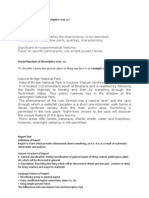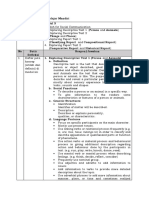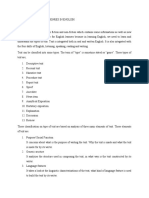Descriptive
Uploaded by
Rizqa Anisa FadhilahDescriptive
Uploaded by
Rizqa Anisa FadhilahDESCRIPTIVE
Text which lists the characteristic of a person, place or things. It describes living and non-living things, such as animals, plants, town, building, volcanoes, monsoon, motorcars, and etc. Communicative Purpose To describe a particular person, place or thing. Types of Descriptive Text o Autobiography o Magazine (car magazine, fashion magazine, travel magazine, etc) o Specification (state what kind and characteristic of materials to be use) The Organization of Descriptive Text 1. Identification Introduce where or who is the subject being described. 2. Description The supporting part of the paragraph to describe in detail to assist the reader to see and feel the subject. For example, the qualities, appearance, uses, habits, and etc. Grammatical Features Adjectives Pronouns Verb and Verb Phrases Simple Past Tense Simple Present Tense Preposition Nouns, Noun Phrases, and Clauses Adverbs Compound and complex sentences
You might also like
- Summary Modul 3: Descriptive Text Is A MeaningfulNo ratings yetSummary Modul 3: Descriptive Text Is A Meaningful2 pages
- Decriptive Text Definition of Descriptive TextNo ratings yetDecriptive Text Definition of Descriptive Text1 page
- Topic 2 Describing Things (Place, Person, Objects, Etc)No ratings yetTopic 2 Describing Things (Place, Person, Objects, Etc)9 pages
- Purpose and Example Descriptive Text. Descriptive Text Is ANo ratings yetPurpose and Example Descriptive Text. Descriptive Text Is A1 page
- Reading and Writing Skills - Patterns of Text DevelopmentNo ratings yetReading and Writing Skills - Patterns of Text Development14 pages
- Hijau Krem Kuning Ceria Tugas PresentasiNo ratings yetHijau Krem Kuning Ceria Tugas Presentasi8 pages
- Generic Structure of Descriptive Text AreNo ratings yetGeneric Structure of Descriptive Text Are2 pages
- LK 1-Profesional - Bahasa Inggris - Modul 3No ratings yetLK 1-Profesional - Bahasa Inggris - Modul 35 pages
- Bahasa Inggris - Media Modul 3 - KB 2 DescriptiveNo ratings yetBahasa Inggris - Media Modul 3 - KB 2 Descriptive11 pages
- Descriptive Text: Trisukses Vocational High SchoolNo ratings yetDescriptive Text: Trisukses Vocational High School6 pages
- Cream Brown Illustrative Group Project Presentation - 20240829 - 111544 - 0000No ratings yetCream Brown Illustrative Group Project Presentation - 20240829 - 111544 - 000011 pages
- Modul 3 English For Sosial CommunicationsNo ratings yetModul 3 English For Sosial Communications5 pages
- Membaca Pemahaman Teks Deskriptif (Praktek)No ratings yetMembaca Pemahaman Teks Deskriptif (Praktek)38 pages
- Makalah Descriptive Text - Kelompok 4 Bahasa InggrisNo ratings yetMakalah Descriptive Text - Kelompok 4 Bahasa Inggris12 pages
- An Explicit Equation For Friction Factor in PipeNo ratings yetAn Explicit Equation For Friction Factor in Pipe2 pages
- Human Resource Management Assignment Case Study - Job Analysis at Go-ForwardNo ratings yetHuman Resource Management Assignment Case Study - Job Analysis at Go-Forward11 pages
- Elsa Online. ElsaWin. ElsaWeb. VW1.6 L - 75 KW - Simos, Engine Code ALZ, From October 2000No ratings yetElsa Online. ElsaWin. ElsaWeb. VW1.6 L - 75 KW - Simos, Engine Code ALZ, From October 20001 page
- Theology and The Curriculum: Univer1Jit11, Is Still Seen As A Major Philosophical Statement On The NaNo ratings yetTheology and The Curriculum: Univer1Jit11, Is Still Seen As A Major Philosophical Statement On The Na11 pages
- DBM CSC Form No. 1 Position Description Forms BlankNo ratings yetDBM CSC Form No. 1 Position Description Forms Blank1 page
- Updated Course Material 5 in Math 2 For 2nd Semester 2021 2022 For DistributionNo ratings yetUpdated Course Material 5 in Math 2 For 2nd Semester 2021 2022 For Distribution14 pages
- Cell Line Profile: ECACC Catalogue No. 84113001No ratings yetCell Line Profile: ECACC Catalogue No. 841130012 pages
- St. Bernard Parish Gov't v. United States, No. 05-1119L (Fed. Cl. May 1, 2015)100% (1)St. Bernard Parish Gov't v. United States, No. 05-1119L (Fed. Cl. May 1, 2015)74 pages

























































































